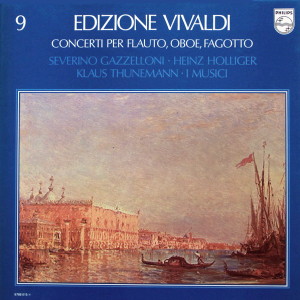 |
|
5 LP's
- 6768 015 - (c) 1978
|
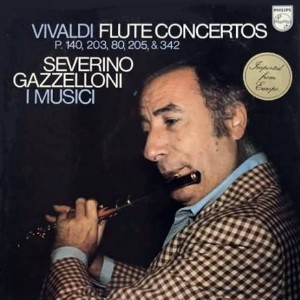 |
| 1 LP -
6500 707 - (p) 1974 |
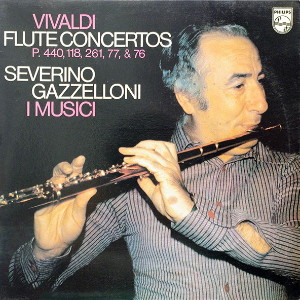 |
| 1 LP -
6500 820 - (p) 1974 |
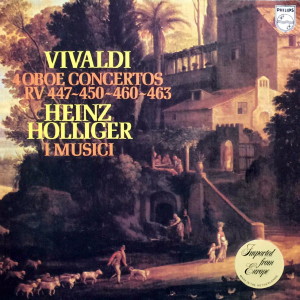 |
| 1 LP -
9500 044 - (p) 1976 |
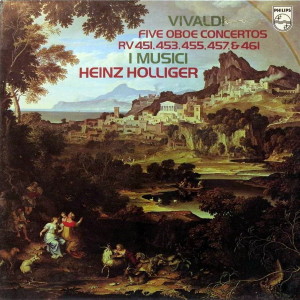 |
| 1 LP -
9500 299 - (p) 1977 |
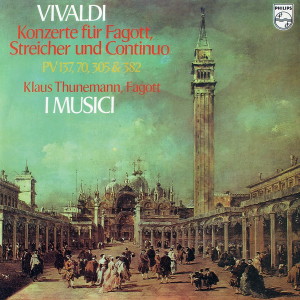 |
| 1 LP -
6500 919 - (p) 1975 |
|
| EDIZIONE
VIVALDI - Vol. 9 |
|
|
|
|
|
|
|
| Antonio
Vivaldi (1678-1741) |
|
|
|
|
|
|
|
Long Playing
1 - (6500 707)
|
|
52' 27" |
|
| Flute Concertos |
|
|
|
| -
Concerto G-dur für Flöte, Streicher
und Continuo, RV/R. 436 (P. 140) |
10' 53"
|
|
|
| -
Concerto D-dur für Flöte, Streicher
und Continuo, RV/R. 427 (P. 203) |
10' 37" |
|
|
-
Concerto a-moll für Flöte, Streicher
und Continuo, RV/R. 440 (P. 80) - inizio
(Allegro non troppo)
|
4' 07" |
|
|
|
|
|
|
| -
Concerto a-moll für Flöte, Streicher
und Continuo, RV/R. 440 (P. 80) - fine
(Larghetto · Allegro) |
6' 41" |
|
|
-
Concerto g-moll für Flöte, Fagott,
Streicher und Continuo "La notte",
RV/R. 439 (P. 342) - op. 10/2
|
10' 24" |
|
|
| -
Concerto D-dur für Flöte, Streicher
und Continuo, RV/R. 429 (P. 205) |
9' 45" |
|
|
Long Playing
2 - (6500 820)
|
|
47' 14" |
|
| Flute
Concertos |
|
|
|
| -
Concerto c-moll für Flöte, Streicher
und Continuo, RV/R. 441 (P. 440) |
12' 56" |
|
|
| -
Concerto G-dur für Flöte, Streicher
und Continuo, RV/R. 438 (P. 118) |
10' 57" |
|
|
|
|
|
|
| -
Concerto F-dur für Flöte, Oboe,
Fagott, Streicher und Continuo "La
tempesta di mare", RV/R. 433 (P.
261) |
7' 04" |
|
|
| -
Concerto a-moll für Flöte, Streicher
und Continuo, RV/R. 108 (P. 77) |
7' 58" |
|
|
| -
Concerto C-dur für zwei Flöten,
Streicher und Continuo, RV/R. 533
(P. 76) |
8' 19" |
|
|
Long Playing
3 - (9500 044)
|
|
47' 02" |
|
| 4
Oboe Concertos |
|
|
|
| -
Concerto a-moll für Oboe, Streicher
und Continuo, RV/R. 463 |
9' 35" |
|
|
| -
Concerto C-dur für
Oboe, Streicher und
Continuo, RV/R. 447
(P. 41) |
14' 47" |
|
|
|
|
|
|
| -
Concerto g-moll für
Oboe, Streicher und
Continuo, RV/R. 460 |
11' 46" |
|
|
| -
Concerto C-dur für
Oboe, Streicher und
Continuo, RV/R. 450
(P. 50) |
10' 54" |
|
|
Long Playing
4 - (9500 299)
|
|
47' 34" |
|
| Five
Oboe Concertos |
|
|
|
| -
Concerto C-dur für
Oboe, Streicher und
Continuo, RV/R. 451
(P. 44) |
9' 04" |
|
|
| -
Concerto F-dur für
Oboe, Streicher und
Continuo, RV/R. 457 |
11' 02" |
|
|
| -
Concerto a-moll für
Oboe, Streicher und
Continuo, RV/R. 461
(P. 42) - inizio
(Allegro non molto) |
3' 47" |
|
|
|
|
|
|
| -
Concerto a-moll für
Oboe, Streicher und
Continuo, RV/R. 461
(P. 42) - fine
(Larghetto · Allegro) |
6' 07" |
|
|
| -
Concerto D-dur für
Oboe, Streicher und
Continuo, RV/R. 453
(P. 187) |
8' 38" |
|
|
| -
Concerto F-dur für
Oboe, Streicher und
Continuo, RV/R. 455
(P. 306) |
8' 56" |
|
|
| Long Playing
5 - (6500 919) |
|
44' 42" |
|
| Konzerte
für Fagott, Streicher und Continuo |
|
|
|
| -
Concerto e-moll für
Fagott, Streicher
und Continuo, RV/R.
484 (P. 137) |
11' 48" |
|
|
| -
Concerto a-moll für
Fagott, Streicher
und Continuo, RV/R.
498 (P. 70) |
11' 13" |
|
|
|
|
|
|
| -
Concerto F-dur für
Fagott, Streicher
und Continuo, RV/R.
489 (P. 305) |
10' 45" |
|
|
| -
Concerto B-dur für
Fagott, Streicher
und Continuo, RV/R.
502 (P. 382) |
10' 56" |
|
|
|
|
|
|
Flute Concertos
(6500 707)
|
Flute
Concertos (6500 820)
|
4 Oboe
Concertos (9500 044)
|
|
| Severino
Gazzelloni, Flöte |
Severino
Gazzelloni, Flöte |
Heinz Holliger, Oboe |
|
| Jiri Staviček,
Fagott (439) |
Marja Steinberg,
2 Flöte (533) |
I MUSICI |
|
| I MUSICI |
Bernard Schenkel,
Oboe (433) |
|
|
|
Jiri Staviček,
Fagott (433) |
|
|
|
I MUSICI |
|
|
|
|
|
|
|
|
|
|
Five
Oboe Concertos (9500 299)
|
Konzerte
für Fagott (6500 919) |
|
|
| Heinz Holliger,
Oboe |
Klaus Thunemann,
Fagott |
|
|
| I MUSICI |
I MUSICI |
|
|
|
|
|
|
Luogo
e data di registrazione |
|
La
Chaux-de-Fonds (Svizzera) - luglio
1973 (Flute Concertos [6500 707])
La Chaux-de-Fonds
(Svizzera) - settembre 1973
(Flute Concertos [6500 820])
La
Chaux-de-Fonds (Svizzera) -
luglio 1975 (4 Oboe Concertos)
La
Chaux-de-Fonds (Svizzera) -
settembre 1976 (Five Oboe
Concertos)
La
Chaux-de-Fonds (Svizzera)
- settembre 1974 (Konzerte
für Fagott)
|
|
|
Registrazione: live /
studio |
|
studio |
|
|
Producer / Engineer |
|
- |
|
|
Prima Edizione
originale LP |
|
Philips
- 6500 707 - (1 LP) - durata 52'
27" - (p) 1974 - Analogico -
(Flute Concertos [6500 707])
Philips - 6500 280 - (1 LP) -
durata 47' 14" - (p) 1974 -
Analogico - (Flute Concertos [6500
820])
Philips - 9500 044 -
(1 LP) - durata 47' 02" - (p)
1976 - Analogico - (4 Oboe
Concertos)
Philips - 9500 299
- (1 LP) - durata 47' 34" -
(p) 1977 - Analogico - (Five
Oboe Concertos)
Philips - 6500
919 - (1 LP) - durata
44' 42" - (p) 1975 -
Analogico - (Konzerte
für Fagott)
|
|
|
Note |
|
-
|
|
|
|
|
|
|
FLUTE
CONCERTOS
The great musical
revolutions have tended to
occur every three hundred
years. The major figures
in these revolutions have
seen themselves as
innovators and have
expressly set as their
goal the creation of a
wholly new and different
type of music. In a
treatise which appeared in
France in 1320 and was
entitled “Ars nova,” this
latter term is assigned to
that refined music which,
in its perfect combination
of multi-part composition
and lyric poetry, raised
music for the first time
to the level of a free,
autonomous art. Soon after
1600 the Florentine
composer Giulio Caccini
gave the title “Nuove
Musiche” to his volume of
solo vocal music with
keyboard or lute
accompaniment. Thus the
Baroque era was introduced
by a new lyrical art as
well as by the new
dramatic art of opera. And
finally, immediately after
the First World War, there
came to the fore in
Central Europe that
progressive form of
composition which
signalled the imminent
demise of late
Romanticism, with its
dissolution of tonality;
this was expressly
proclaimed as “New Music.”
The revolutionaries are
followed by the great
masters who put their
creative stamp upon what
has been delivered into
their hands by the
“inventors” and theorists
of “New Music.” Antonio
Vivaldi was a child of
such an inventive century
(the seventeenth);
in his works, stamped with
the seal of creative
greatness and
craftsmanlike mastery,
lies the grandiose
confirmation and
justification of all the
foregoing revolutionary
tumult, which had
completely changed the
face of music as it had
been known up to that
time. In the century
before Vivaldi, music had
still derived its strength
from an indissoluble union
between singer and player,
a marriage which could not
have been broken without
losses being sustained.
Vivaldi was the first
composer to bring about an
indisputable emancipation
of pure instrumental
music, creating a music
which only follows its own
laws and even claims
superiority to vocal
music. The former thus
attains a new and central
musical status. This was a
decisive move on Vivaldi’s
part, a move of greatest
consequence and it
received its triumphant
justification in the works
of Bach, Handel, and the
Viennese Classicists. It
was only in the
instrumental works of
Vivaldi that the last
echoes of so-called
Renaissance music finally
died away; a new musical
age had superseded the
last. All aspects of
Vivaldi’s instrumental
music also symbolise and
provide striking evidence
of the social changes of
the age. Seldom has a
whole family of
instruments been as
thoroughly eclipsed as
when Vivaldi replaced the
instruments of Renaissance
music with his own
fully-fledged Baroque
grouping. In place of a
body of sound made up of a
series of homogeneous
sound-groups, which
symbolised community, the
Baroque substituted a
grouping in which a gulf
between “ruling” and
“serving” instruments
became all too apparent.
Thus the era of musical
absolutism was ushered in.
The mass of mere
accompanying instruments
was subordinated to an
élite of instrumental
soloists.
Many instruments used in
Renaissance music now
disappeared. There were,
however, a few which
succeeded in keeping up
with and surviving the
development in solo
virtuosity. Others, which
till that point had led a
peripheral existence in
musical art, emerged from
their anonymity and set
themselves at the head of
the triumphant procession
of Baroque music. The
violin, thanks to its
high-soaring capacity, its
penetrating tone, and its
potential for virtuoso
display, assumed its now
unquestioned leading role.
For this instrument alone
Vivaldi wrote 250 solo
concertos, not least
because he himself was an
excellent violinist.
Among the brass and
woodwind it was a hitherto
little-known instrument,
the flute, which, since it
shared similar virtues to
that of the violin,
suddenly came to the fore
as a popular and admired
solo instrument. Vivaldi
wrote for the flute,
including besides duets,
11 complete concertos,
which resemble in their
architectonic structure
the three-movement violin
concertos. With regard to
their characteristic
features, however -
including the conscious
attempt to paint “sound
pictures,” - they were
wholly tailored for this
expressive instrument.
Among the flute concertos,
there is an unmistakable
“programme” work in the G minor
Concerto, “La notte,”
which by the introduction
of a bassoon and a solo
violin mysteriously evokes
the night. The climax of
this great work is an
interpolated movement, “Il
sonno” (Sleep) which, with
its restlessness, suggests
to the listener the
visions of a dream-like
state of consciousness.
In earlier epochs of
Western music, there was
no symphonic programme
music, as for example of
the kind Franz Liszt and
Richard Strauss composed,
but there existed
“pictorial” compositions.
Among roughly 450
instrumental concertos by
Vivaldi, there are no
small number, a good two
dozen in fact, whose
titles point to some
“pictorial” intention or
to that of depicting a
particular milieu. Among
them there are concertos
which, like the cycle “The
Four Seasons,” already
became famous during the
composer’s lifetime and
which, in today’s Vivaldi
renaissance, have aspired
to universal fame. Apart
from “La notte” the F
major Concerto entitled
“La tempesta di mare”
(Storm at Sea) also
belongs to these
“pictorial” works. This
piece, apart from the
occasional interpolation
of brass instruments and a
short Largo, has an
orchestral character.
Especially in the first
movement, you feel you can
hear and see the waves of
the storm-tossed sea
rising, falling, and
breaking. And even in the
Largo the unisono
of the storm breaks in
upon the peaceful episode
between the two
tempestuous movements.
Karl
Grebe
OBOE
CONCERTOS
On August 12, 1703 the
Governors of the Pio
Ospedale della Pietà,
decided to appoint
teachers of violin and
oboe on the recommendation
of the musical director.
Later that autumn Vivaldi,
newly ordained
as a priest, joined the
staff, on which he served
in various capacities
connected with the
teaching of the violin and
the direction of the
orchestra for the best
part of 40 years (with
several long breaks). Four
years later Ludwig Erdmann
was appointed as the long
overdue oboe teacher. He
stayed, however, for only
two years at the most,
departing to serve the
Grand Duke of Tuscany, and
the post fell vacant. In
June
1713 lgnazio Siber became
oboe master, but he left
in 1715 and had to be
replaced by Onofrio
Penati, a veteran of the
St. Mark’s orchestra.
Penati’s employment ceased
in 1722; possibly through
death or infirmity, and
thereafter the post was
left unfilled.
Vivaldi may well have
written his oboe concertos
(20 for one oboe, three
for two oboes, one for
oboe and bassoon, and two
for oboe and violin - not
to speak of the
instrument’s frequent
appearance in ensemble
concertos) for any of
these three men or their
best pupils. Some of the
concertos were undoubtedly
used - though not
necessarily originally
written - to fulfil
commissions from outside
the Pietà.
Because very few of
Vivaldi’s compositions can
be accurately dated, it
would be hazardous to
claim that his oboe
concertos were the first
to be written. It
is likely that the
Germans, who became
familiar with the oboe as
a vehicle of virtuosity
earlier than the Italians,
were in the field before
him. The earliest
published oboe concertos
by an Italian were the
eight in Tomaso Albinoni’s
“Concerti
a cinque,” Op. 7, which
came out in 1715. Very
soon, examples by other
Venetians such as
Alessandro Marcello and
Vivaldi himself also
appeared.
Because the oboe had not
yet fully established
itself in Italy, home of
the voice and the violin,
the style of writing for
it was often patently
modelled on a pre-existing
one: Albinoni tended to
treat the solo oboe rather
like a vocal soloist,
emphasising its cantabile
qualities; Vivaldi, as one
might expect from Europe’s
foremost violin virtuoso,
was inclined to treat it
very much like a stringed
instrument, stretching to
the utmost its capacity to
execute rapid, arpeggiated
passage-work and sometimes
leaving the player little
opportunity to draw
breath.
The forms used in
Vivaldi’s oboe concertos
do not differ from the
ones he established at the
outset of his career in
his violin concertos. The
typical form of his outer
movements is characterised
by the alternation of a
ritornello, or refrain,
scored for the full
ensemble, and various
episodes, in which the
soloist comes into
prominence. Ritornellos
are further distinguished
by relative stability of
key and a common fund of
thematic ideas, episodes
by their propensity to
modulate and the free
derivation (or invention)
of their musical material.
The Concerto in A minor,
RV 463 originated as the
bassoon concerto RV 500.
In its new guise it
retains the tutti
sections note for note,
substituting fresh solo
portions. The opening Allegro
is interesting for the way
in which it introduces ritornello
ideas into the episodes as
a background to the
soloist, a feature more
commonly found in Bach.
The finale brings a
surprise, as it does not
return to A minor but
stays in C major, the key
of the second movement.
Mistake or no, Vivaldi did
not attempt to correct it
when rescoring the work -
and with good reason, for
this finale is a strong
movement with more than a
hint of fugue.
The Concerto in C, RV 447
exists in two other
versions, one for bassoon
(RV 470) and the other
also for oboe (RV 448),
which have different
finales. The opening Allegro
non molto
exemplifies Vivaldi’s
“violinistic” treatment of
the oboe. Note also the
particularly wide
fluctuations in harmonic
rhythm (the rate of chord
change). The Larghetto
presents a cantilena
over a typically Vivaldian
accompaniment of pulsating
chords on the upper
strings; it is introduced
by a sombre ritornello,
whose last chords round
off the movement. The
finale is one of Vivaldi’s
fairly rare variation
movements, frankly
”concertante” in style.
RV 460 was published as
No. 6 of Vivaldi’s Op. 11
in 1729. It must have lain
on the composer’s shelf
for some while, as an
adaptation of it for
violin appeared as his Op.
9 No. 3 (RV 334, Ricordi
127) in 1727! G minor is
for Vivaldi a stormy key;
the feeling of
restlessness is enhanced
in the first movement by
the unusual chord (a
second inversion of the
subdominant chord) on
which the ritornello
opens. The second movement
resembles that of the
famous concerto in A minor
for two violins, Op. 3 No.
8, in being built over a
modulating ground-bass.
RV 450 is another bassoon
concerto arranged for oboe
by the composer. In the
opening Allegro molto
note the variety and
number of musical ideas.
The Larghetto, in
A minor, is conceived as a
very florid cantabile
outpouring for the oboe,
interrupted from time to
time by a short, unison
motto on the strings; the
first violin adds a few
long-breathed phrases.
Snatches of canon between
the two violins against a
buzz of repeated notes on
the viola set the tone for
the finale, a
light-hearted whirl.
The Concerto in C, RV 451
is written in a simple,
appealing style. The
ritornellos of its outer
movements both exploit one
device of which Vivaldi,
anticipating Schubert, was
especially fond: the
juxtaposition of major and
minor versions of the same
key. In
the slow movement the
ritornello is reduced to a
simple frame around an
extended solo portion.
RV 457. is an adaptation
by the composer of his
Bassoon Concerto RV 485,
whose style shows it to be
a late work. In
the first two movements
the ritornellos and, for
the most part, the
accompaniment to the solo
episodes have been taken
over as they stand, but
the finale has been
thoroughly reworked. Note
in the finale the
“masculine” opening and
the “feminine” riposte
(where the bass drops out)
- a foretaste of the
Classical style.
The first movement of RV
461 is unusual for Vivaldi
in the high degree of
thematic integration it
evinces. Much of the
melodic writing, and even
more of the accompaniment,
in the solo episodes can
be traced back to
ritornello material. The
slow movement has a simple
framing ritornello as in
RV 451. “Lombard” rhythms,
in which a long main note
is preceded by two very
short notes beginning on
the beat, are prominent in
the finale.
In RV 453 the ritornello
of the first movement
begins (disregarding a
quaver upbeat) with an
anapaestic rhythm very
frequent in Vivaldi’s
music but rare in that of
his contemporaries, and
which suggests Slavonic
folk-music. The D minor
slow movement is scored,
like that of a solo
sonata, for oboe and
continuo alone. A rhythmic
subtlety reminiscent of
the last movement of
Mozart’s Oboe Quartet
occurs in the finale:
although the metre is 12/8
alla
giga, the beats are
sometimes divided into
four instead of three in
the solo part.
The surviving manuscript
of RV 455 is non-autograph
but bears the autograph
inscription “per Sassonia”
(for Saxony, i.e. the
Dresden Court). An unusual
feature of the ritornello
of the opening movement is
the obbligato
part of the soloist, who
usually merely has to
double the first violin.
The accompaniment in all
three movements is
unusually lean, making
ample use of unisons,
while the solo writing is
lively and extrovert.
Michael
Talbot
BASSOON
CONCERTOS
Composers have been
ungenerous to the bassoon
as a solo instrument in
concertos. Mozart’s early
concerto in B flat (K.
191) is probably the only
bassoon concerto included
in the standard
repertoire. But if one
composer could make amends
for all it would be
Vivaldi. Peter Ryom lists
39 solo concertos for
bassoon - almost as many
as Vivaldi’s concertos for
all other woodwind
instruments combined! As
37 of them (the remaining
two being incomplete) have
been made available to
modern players in
Ricordi’s collected
edition we almost have an
embarras de richesse
(The Ricordi numbers of
the Concertos recorded
here are, in order of
appearance, 71, 28, 266,
and 270.)
All Vivaldi’s bassoon
concertos survive in
autograph manuscripts
contained in the volumes
of the great Foà
and Giordano collections
now housed in the
Biblioteca Nazionale,
Turin. It is believed that
these volumes are the main
repository of works
written by Vivaldi for the
Pio Ospedale della Pietà
during his long years of
service there as a violin
teacher and leader of the
orchestra (the Pietà
was an orphanage for girls
which, like three other
similar institutions in
Venice, also served as a
musical academy). Vivaldi
must have had a talented
bassoon-player
among his colleagues or
their pupils to have
endowed this instrument so
richly. The autograph
score of the Concerto in B
flat (RV 502) carries a
superscription (later
deleted) designating the
work for a certain
Giuseppe Biancardi, who is
known to have been a
member of the Venetian
instrumentalists' guild.
Another concerto (RV 496)
bears the name of Count
Morzin, the patron to whom
Vivaldi dedicated his Op.
8.
The two-keyed bassoon for
which Vivaldi wrote these
works was substantially
the same as the modern
instrument, save that its
lowest note was C instead
of B flat. His treatment
of the instrument - now
broad and lyrical, now
perkily virtuosic with
wide leaps and rapid scale
passages - owes much to
the style of his writing
for solo cello, rather as
his solo parts for flute,
recorder, and oboe
constantly recall the
violin. Nevertheless,
Vivaldi was alert to the
special needs of his
wind-players (such as
frequent opportunities to
draw breath) and skilfully
turned them to musical
advantage, as in the
“stutters” during the
second movement of RV 498.
Almost as a matter of
course Vivaldi directs his
soloists to play together
with the corresponding
orchestral part during tutti
sections, which means that
the bassoon doubles the
cellos. There was a sound
practical reason for this:
one could ill afford to
dispense with the services
of the ablest players
during the most weighty
passages! Another almost
universal practice was the
lightening of the texture
during solo episodes. At
its most economical the
accompaniment would
consist of cello and
continuo alone or (a
Vivaldian speciality) a
single line on upper
strings - unison violins,
sometimes reinforced by
violas. When
the solo instrument -
bassoon or cello - lies in
a low register the solo
instrument - bassoon or
cello - lies in a low
register one often has the
curious experience of
hearing what is
recognisably a bass line above
an obvious melody line! On
other occasions the
accompaniment may consist
of several strands and
command interest in its
own right, either through
its interplay with the
soloist or its recall of
material from the tutti
sections. Walter Kolneder
observes that the motivic
interest of the
accompaniment is
particularly marked in the
woodwind concertos and
suggests that the contrast
between wind and string
timbre encouraged the
composer to write
elaborate accompaniments
without fear of swamping
the principal instrument.
Since the same feature is
found in the cello
concertos, however,
perhaps it would be
equally correct in the
case of the bassoon
to explain it by the
contrast of register.
The form of the fast outer
movements conforms to the
usual Vivaldian pattern. A
lengthy ritornello
consisting of a number of
complementary thematic
ideas opens the movement.
It
is restated, often in
abridged or modified form,
three or four times. The
last statement is
naturally in the home key,
while intermediate
statements are normally in
different keys. Solo
episodes intervening
between the ritornellos
effect the necessary
modulations. To allow the
soloist the chance of
repeating his opening
“motto” (often a
paraphrase of a ritornello
idea) in its original key
at the head of the final
episode, the ritornello
coming immediately before
is often given out in the
home key or diverted to it
in mid-course. The final
episode frequently ends
with a brief quasi-cadenza
over a pedal point.
A simplified version of
this logical and flexible
plan is commonly employed
in the slow movements.
Sometimes all that remains
of a ritornello is a short
introduction-cum-conclusion,
as in RV 502. The slow
movement of RV 489 even
dispenses with this,
becoming almost
indistinguishable from a
sonata movement.
In these bassoon
concertos, which must be
products of his full
maturity, Vivaldi
sometimes approaches the
new galant idiom of Galuppi
and Pergolesi; one may
instance the ritornellos
in RV 489. But many
features remain uniquely
Vivaldian, such as the
rocking syncopations in
the first movement of RV
502 and the stark unisons
in the slow movement of RV
484. In the final
analysis, the most
original quality of this
music is its utter
spontaneity - its ability
to lead the listener along
unexpected paths at the
risk of occasionally
disappointing him, but
more often revealing some
rare delight.
Michael
Talbot
|
|

